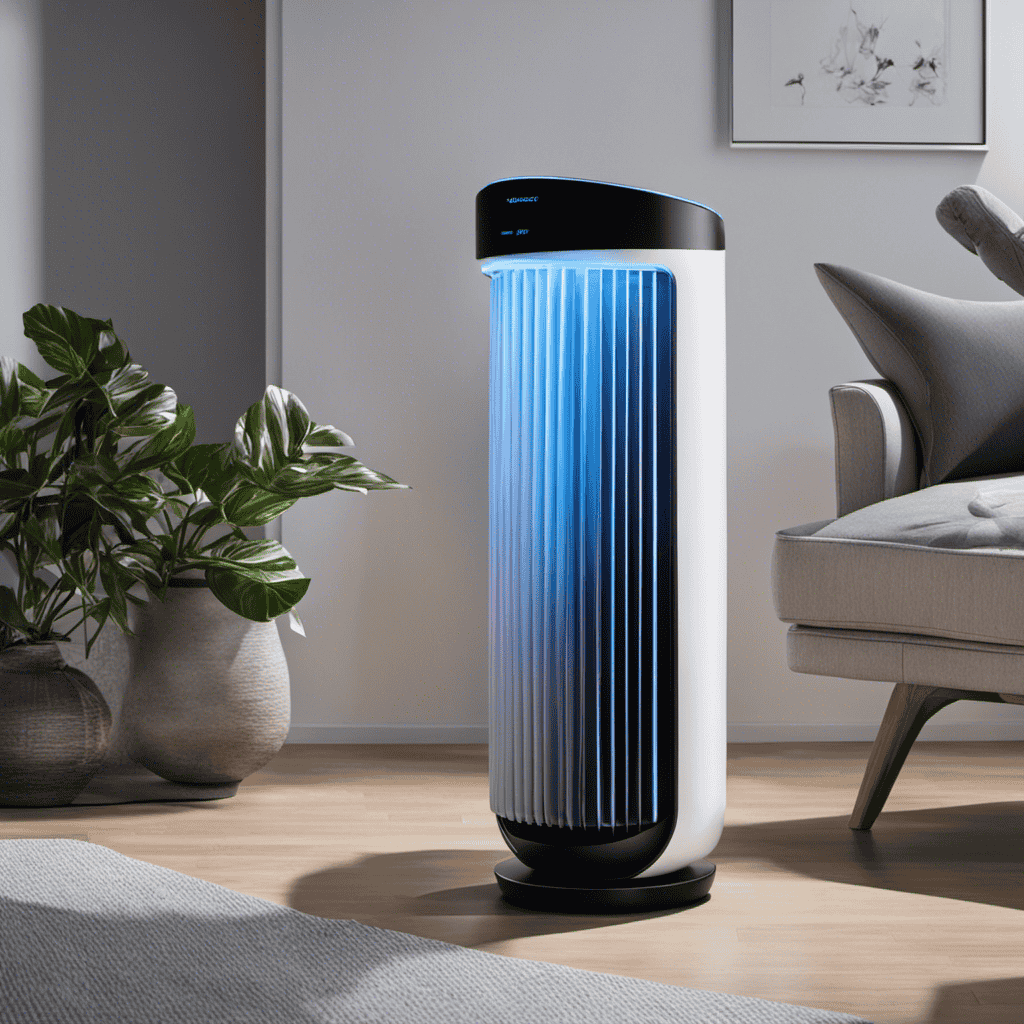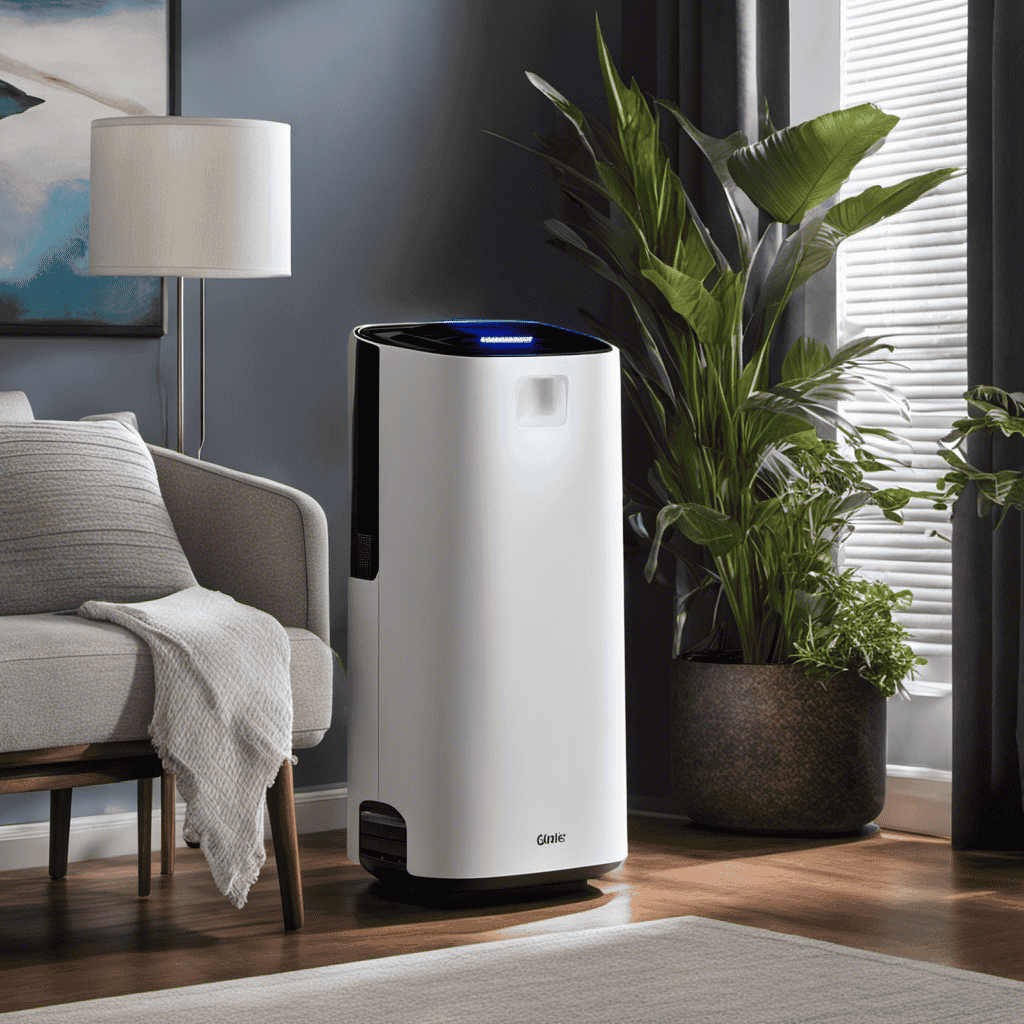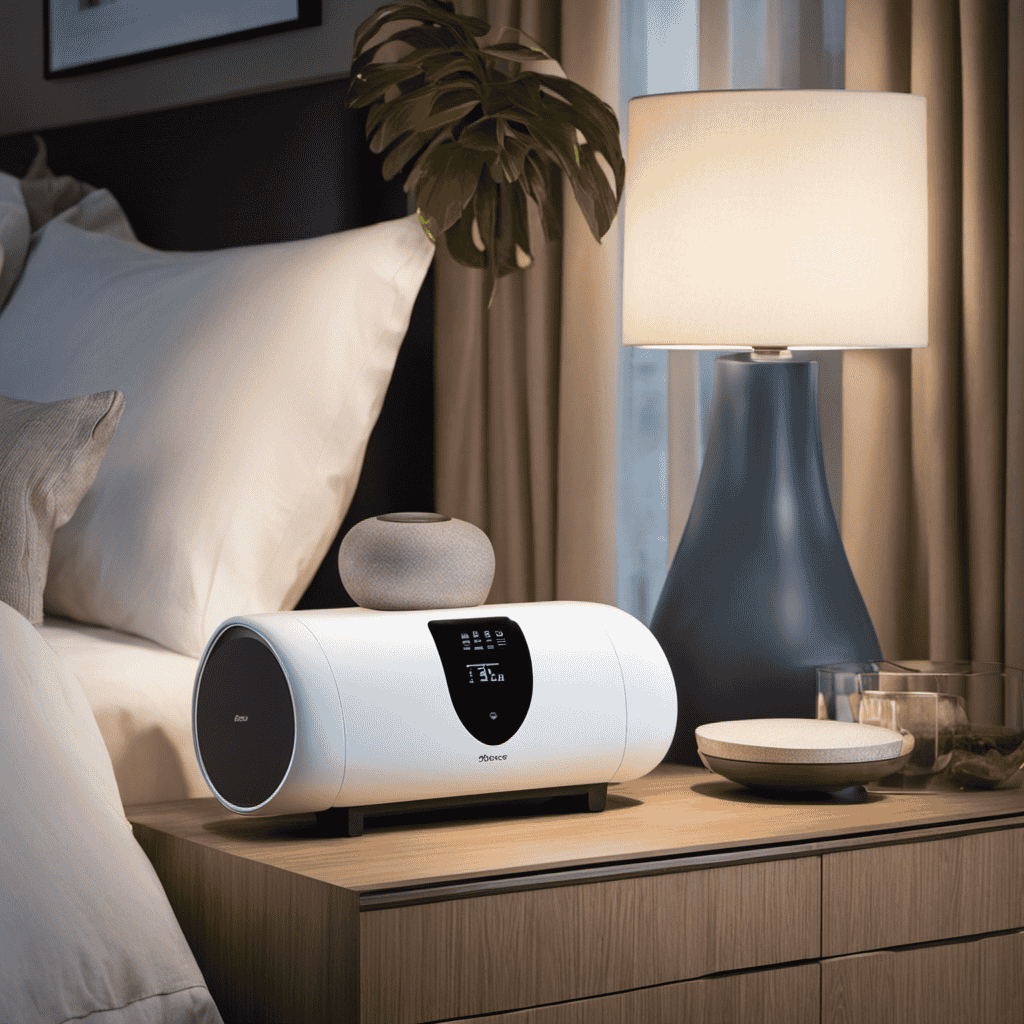Types of Air Purifiers: HEPA, Carbon, Ionic, and More
As an air quality expert, I have delved deep into the world of air purifiers. Let me be your guide as we explore the various types available to help you breathe easier.
From the highly efficient HEPA air purifiers to the odor-fighting carbon models, and the ionizing wonders, we will uncover the strengths and weaknesses of each.
Join me on this journey as we unravel the mystery behind these air-cleansing machines and find the perfect one for your needs.
Key Takeaways
- HEPA air purifiers are highly effective in removing dust, pollen, pet dander, and mold spores. Regular maintenance and filter replacement are crucial for optimal performance.
- Carbon air purifiers are effective in removing odors, gases, and chemicals, particularly volatile organic compounds (VOCs). They work alongside other filtration technologies like HEPA filters to improve indoor air quality.
- Ionic air purifiers efficiently neutralize airborne bacteria and viruses, remove fine particles, and may have potential health benefits like reducing asthma symptoms. They emit negatively charged ions that attach to particles, causing them to fall to the ground and improve air quality.
- UV-C air purifiers use ultraviolet light to kill germs and bacteria in the air. Direct exposure to UV-C light can be harmful, so safety precautions should be followed. Ozone air purifiers eliminate odors but can be harmful to respiratory health due to ozone emission.
HEPA Air Purifiers
HEPA air purifiers are known for their ability to filter out small particles and allergens. These purifiers are equipped with High-Efficiency Particulate Air (HEPA) filters, which are designed to capture 99.97% of particles as small as 0.3 microns. This makes HEPA filters highly effective in removing common airborne contaminants such as dust, pollen, pet dander, and mold spores.
To ensure the effectiveness of a HEPA air purifier, it is important to regularly maintain the HEPA filter. This involves replacing the filter as recommended by the manufacturer, usually every 6 to 12 months. Additionally, it is crucial to clean the pre-filter regularly to prevent larger particles from clogging the HEPA filter and reducing its efficiency.
HEPA filters are designed to be highly efficient and reliable, but their effectiveness can be compromised if they are not properly maintained. Regularly replacing and cleaning the filters not only ensures optimal performance but also prolongs the lifespan of the air purifier.
Carbon Air Purifiers
When it comes to air purification, carbon filters are a popular choice. They are highly effective in removing odors, gases, and chemicals from the air. Carbon filters work through a process called adsorption, where the activated carbon in the filter traps and holds onto impurities in the air. They are particularly effective at removing volatile organic compounds (VOCs) and neutralizing unpleasant smells. Carbon air filters are an essential component of many air purifiers, working alongside other filtration technologies like HEPA filters. Now, let’s explore another type of air purifier: ionic air purifiers.
Ionic Air Purifiers
I have found that Ionic Air Purifiers have several pros that make them an attractive option for improving indoor air quality.
They are known for their ability to remove fine particles from the air, such as dust, pollen, and pet dander.
Additionally, their efficiency in ionization allows them to effectively neutralize airborne bacteria and viruses, providing a healthier environment.
Moreover, there are potential health benefits associated with using Ionic Purifiers, such as reducing asthma symptoms and improving respiratory health, as they can help remove allergens and irritants from the air we breathe.
Pros of Ionic Purifiers
Ionic purifiers are known for their ability to remove harmful particles from the air. These purifiers use a process called ionic purification, which involves the emission of negatively charged ions into the air. These ions attach themselves to positively charged particles, such as dust, pollen, and pet dander, causing them to become heavy and fall to the ground.
Here is a comparison of ionic purifiers with other types:
-
Effectiveness: Ionic purifiers are highly effective at removing particles as small as 0.01 microns, which is smaller than what HEPA filters can capture.
-
Odor elimination: Ionic purifiers can also eliminate odors from the air by neutralizing the charged particles that cause them.
-
Energy efficiency: Ionic purifiers are generally more energy-efficient compared to other types, such as carbon filters or UV purifiers, making them a cost-effective option for continuous use.
Efficiency of Ionization
To maximize efficiency, consider placing your ionization purifier in a central location within your home.
Ionization purifiers work by emitting negative ions into the air, which attach to positively charged particles like dust, allergens, and bacteria, causing them to become heavy and fall to the ground. This process helps to remove these particles from the air, improving indoor air quality.
Studies have shown that ionization purifiers can be effective in reducing the levels of airborne contaminants. Additionally, some research suggests that negative ions may have potential health benefits, such as improving mood, reducing stress, and enhancing overall well-being.
However, it is important to note that ionization purifiers may produce small amounts of ozone as a byproduct, which can be a concern for individuals with respiratory conditions. Therefore, it is crucial to choose an ionization purifier that meets safety standards and follow manufacturer guidelines for proper usage.
Potential Health Benefits
Placing an ionization purifier in a central location can potentially improve mood and overall well-being. Here are three potential health benefits of using an ionization purifier compared to traditional methods:
-
Reduction of airborne particles: Ionization purifiers release negatively charged ions that attach to positively charged particles, causing them to fall out of the air and onto surfaces. This helps to remove allergens, dust, and other pollutants from the air, leading to improved respiratory health.
-
Odor elimination: Ionization purifiers can neutralize unpleasant smells by breaking down volatile organic compounds (VOCs) and other odor-causing substances. This can be particularly beneficial for individuals with sensitivities to certain smells or for those living in areas with high levels of pollution.
-
Enhanced mental well-being: Some studies suggest that negative ions produced by ionization purifiers can increase the production of serotonin, a neurotransmitter that promotes feelings of happiness and relaxation. This can potentially lead to improved mood, reduced stress, and increased overall well-being.
While ionization purifiers offer potential health benefits, it is important to consider potential risks associated with high levels of ozone production. Now, let’s explore the benefits of UV-C air purifiers.
UV-C Air Purifiers
When it comes to UV-C air purifiers, there are several key points to consider.
First, their effectiveness against germs is well-documented, as UV-C light has been shown to kill or deactivate a wide range of bacteria, viruses, and other pathogens.
Second, the safety of UV-C technology is an important factor to address, as prolonged exposure to UV-C light can be harmful to humans and can damage materials.
Lastly, it is essential to compare UV-C air purifiers to other methods of air purification to determine their advantages and disadvantages in terms of cost, efficiency, and overall performance.
UV-C Effectiveness Against Germs
UV-C light is highly effective in killing germs and bacteria in the air. This type of light, also known as ultraviolet germicidal irradiation (UVGI), has been used for decades to disinfect air and surfaces in various settings.
Here are three reasons why UV-C light is a powerful tool in germ eradication:
-
UV-C Germicidal Lamps: UV-C lamps emit short-wavelength ultraviolet light that damages the genetic material of microorganisms, preventing them from reproducing and causing harm.
-
UV-C Light Disinfection: When UV-C light is exposed to germs and bacteria, it disrupts their DNA, RNA, or proteins, rendering them inactive and unable to cause infections.
-
High Effectiveness: Numerous studies have demonstrated the efficacy of UV-C light in killing a wide range of pathogens, including viruses, bacteria, and fungi.
UV-C light provides a potent method for air purification and germ eradication. However, it is essential to understand the safety considerations associated with this technology.
Safety of UV-C Technology
Using UV-C technology can be a safe and effective way to eliminate germs and bacteria in various settings. UV-C light has been proven to be highly effective in killing microorganisms, including viruses, bacteria, and mold spores. However, there are some safety precautions to consider when using UV-C devices. Direct exposure to UV-C light can be harmful to the skin and eyes, causing burns and potential damage. Therefore, it is important to use UV-C devices in a controlled manner and follow safety guidelines. Additionally, there are concerns about the potential generation of ozone during the UV-C disinfection process. Ozone can be harmful when present in high concentrations, so it is crucial to choose UV-C devices that have built-in ozone-free technology. Overall, when used correctly and responsibly, UV-C technology can provide an effective and safe solution for germ elimination.
| Pros | Cons |
|---|---|
| Highly effective in killing germs | Potential harm to skin and eyes |
| Wide range of applications | Generation of ozone |
| Non-chemical disinfection method | Safety precautions required |
| Does not leave residue | Requires proper training and handling |
UV-C Versus Other Methods?
To compare UV-C technology with other methods, you may want to consider factors such as effectiveness, safety, and ease of use.
When it comes to safety concerns, UV-C technology is generally considered safe for use in air purifiers. However, it is important to note that direct exposure to UV-C light can be harmful to the skin and eyes, so precautions should be taken when operating UV-C air purifiers.
In terms of effectiveness, UV-C technology is highly effective at killing bacteria, viruses, and other microorganisms that may be present in the air. It works by damaging the DNA of these organisms, rendering them unable to reproduce and causing them to die.
When comparing UV-C technology to ozone-based methods, there are some key differences to consider. UV-C technology specifically targets and kills microorganisms, while ozone-based methods work by releasing ozone into the air, which can react with pollutants and neutralize them. However, high levels of ozone can be harmful to human health, so caution should be exercised when using ozone-based air purifiers.
Ozone Air Purifiers
Ozone air purifiers are known for their ability to eliminate odors. These purifiers work by generating ozone, a molecule composed of three oxygen atoms (O3), which is a powerful oxidant. When ozone comes into contact with odors, it breaks down the molecules responsible for the unpleasant smell, effectively removing them from the air. However, while ozone air purifiers may be effective at eliminating odors, they also come with potential health risks.
Ozone is a lung irritant and can cause respiratory problems, especially for individuals with pre-existing conditions such as asthma or chronic obstructive pulmonary disease (COPD). Prolonged exposure to high levels of ozone can also lead to lung inflammation and damage. It is important to note that the ozone levels produced by these air purifiers can vary, and excessive exposure to ozone can be harmful.
To better understand the potential health benefits and risks associated with ozone air purifiers, let’s take a look at the following table:
| Potential Health Benefits | Potential Health Risks |
|---|---|
| Elimination of odors | Lung irritation and inflammation |
| Reduction of airborne bacteria and viruses | Respiratory problems for individuals with pre-existing conditions |
| Removal of mold spores | Lung damage from prolonged exposure to high ozone levels |
It is essential to weigh the benefits against the risks when considering the use of ozone air purifiers. If you have respiratory issues or concerns, it may be advisable to explore alternative types of air purifiers that do not produce ozone.
Photocatalytic Air Purifiers
Photocatalytic air purifiers, also known as PCO air purifiers, utilize a combination of ultraviolet light and a photocatalyst to neutralize and eliminate airborne pollutants. This innovative technology has gained popularity in recent years due to its effectiveness in improving indoor air quality.
Here are three key advantages of using photocatalytic air purifiers:
-
Photocatalytic air purification process: The photocatalytic process involves the activation of a photocatalyst, typically titanium dioxide, by ultraviolet light. When exposed to this light, the photocatalyst generates reactive oxygen species that break down harmful pollutants like volatile organic compounds (VOCs), bacteria, and viruses. These pollutants are transformed into harmless byproducts, such as carbon dioxide and water vapor.
-
Effective against a wide range of pollutants: Unlike other types of air purifiers that target specific pollutants, photocatalytic air purifiers can effectively neutralize a variety of airborne contaminants. This includes common household pollutants like pet dander, dust mites, tobacco smoke, and even certain odors.
-
Long-lasting and low maintenance: Photocatalytic air purifiers have a long lifespan and require minimal maintenance. The photocatalytic process does not consume the photocatalyst, meaning that it does not need to be replaced frequently. Additionally, the elimination of pollutants occurs on a molecular level, ensuring that the air remains clean and fresh for extended periods.
Frequently Asked Questions
Are There Any Air Purifiers That Combine Multiple Technologies, Such as HEPA and Carbon, for Enhanced Air Filtration?
Yes, some air purifiers combine multiple technologies, such as HEPA and carbon, for enhanced air filtration. This is known as multi-stage air filtration.
By combining these different technologies, air purifiers can effectively remove a wider range of pollutants, including allergens, odors, and chemicals. HEPA filters capture small particles, while carbon filters absorb gases and odors.
The combination of these technologies provides a more comprehensive and efficient air purification process, resulting in cleaner and healthier indoor air.
Can Air Purifiers Remove Odors From the Air, Like Cigarette Smoke or Pet Odors?
Yes, air purifiers can effectively remove odors from the air, such as cigarette smoke or pet odors. They work by using various technologies such as activated carbon filters, which are designed to adsorb and neutralize odorous molecules.
This helps to improve indoor air quality by eliminating unpleasant smells and creating a fresher and cleaner environment.
Additionally, air purifiers’ effectiveness against airborne bacteria further contributes to maintaining a healthy indoor environment.
Are There Any Air Purifiers Specifically Designed for People With Allergies or Asthma?
Yes, there are air purifiers specifically designed for people with allergies or asthma. These purifiers use HEPA filters to remove allergens like pollen, dust mites, and pet dander from the air.
They also often include activated carbon filters to remove odors and harmful chemicals. These air purifiers are effective in small spaces and can significantly improve indoor air quality.
It’s important to note that while air purifiers can consume energy, many models are designed to be energy-efficient.
How Often Do the Filters in Air Purifiers Need to Be Replaced, and Is It Easy to Find Replacement Filters?
Filter replacement frequency and the availability of replacement filters are important considerations when purchasing an air purifier. The frequency at which filters need to be replaced varies depending on the type of purifier and the manufacturer’s recommendations.
It is generally recommended to replace filters every 6 to 12 months for optimal performance. Fortunately, replacement filters are usually easy to find and can be purchased from the manufacturer’s website, authorized retailers, or online marketplaces.
Can Air Purifiers Effectively Remove Harmful Gases and Volatile Organic Compounds (Vocs) From the Air?
Yes, air purifiers can effectively remove harmful gases and volatile organic compounds (VOCs) from the air. They work by using different types of filters, such as activated carbon filters, which can absorb and trap these pollutants.
Additionally, some air purifiers use photocatalytic oxidation technology, which can break down VOCs into harmless byproducts. By removing these harmful substances, air purifiers contribute to improving indoor air quality and creating a healthier living environment.
Conclusion
In conclusion, when it comes to choosing an air purifier, it is important to consider the different types available.
HEPA air purifiers are highly effective in removing particles as small as 0.3 microns.
Carbon air purifiers are great for eliminating odors and chemicals.
Ionic air purifiers work by releasing negative ions that attach to pollutants.
UV-C air purifiers use ultraviolet light to destroy bacteria and viruses.
Ozone air purifiers produce ozone gas to neutralize odors.
Lastly, photocatalytic air purifiers use a combination of UV light and a catalyst to break down pollutants.
Interestingly, studies have shown that HEPA air purifiers can remove up to 99.97% of airborne particles, making them a popular choice for those concerned about indoor air quality.










